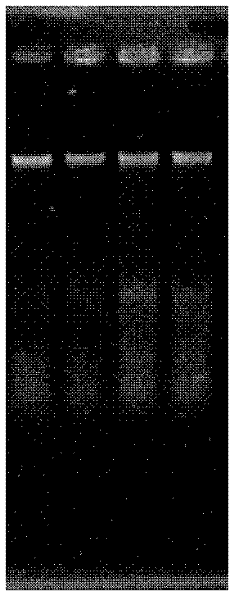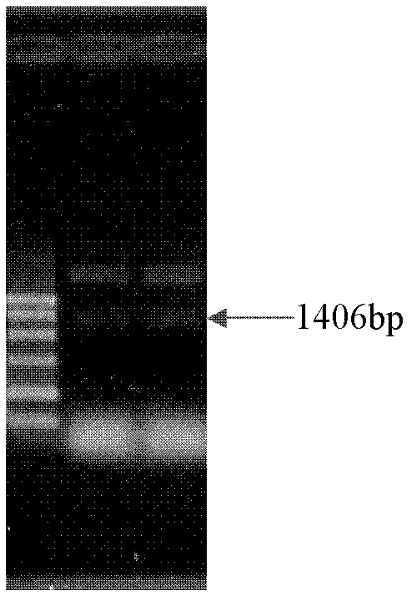Corn low-temperature inducible promoter and activity analysis
A low-temperature induction, promoter sequence technology, applied in the field of bioengineering, can solve the problem of few inducible promoters
- Summary
- Abstract
- Description
- Claims
- Application Information
AI Technical Summary
Problems solved by technology
Method used
Image
Examples
Embodiment 1
[0034] Example 1: Cloning of the low temperature inducible promoter of the maize DRE response element binding protein gene ZmDBP3
[0035] The promoter of the corn DRE response element binding protein gene ZmDBP3 (the promoter sequence comprises the DNA nucleotide sequence of the -1bp to -1151bp region relative to the transcription start site of SEQ ID NO: 1), at the 5th position of the corn ZmDBP3 gene ' region sequence was identified.
[0036]The maize DRE response element binding protein gene ZmDBP3 is registered in NCBI GenBank (accession number: FJ805751.1), and the sequence listing shows the DNA sequence of the plant low-temperature-inducible promoter and 5' untranslated region of the above-mentioned gene of the present invention. In the list of promoter sequences in this document, base C of the transcription initiation site is indicated with +1. And use the promoter analysis website to analyze the core elements of the promoter.
[0037] Promoter analysis website http:...
Embodiment 2
[0042] Embodiment 2: Construction of plant low temperature inducible vector
[0043] The low-temperature-inducible promoter of the maize DRE response element binding protein gene ZmDBP3 cloned in Example 1 and the 255 bp 5' untranslated region ZmDBP3Pro (see sequence listing) were inserted into the vector to construct a plant low-temperature-inducible vector.
[0044] More specifically, the plant expression vector pCAMBIA1301 and the recombinant plasmid pMD18-T::ZmDBP3Pro were respectively digested with EcoRI and NcoI, and then inserted into the EcoRI and NcoI restriction sites of the vector pCAMBIA1301. This vector is called pCAMBIA 1301::ZmDBP3Pro, and is used to drive the expression of GUS gene, identified by PCR ( Figure 4 ) and enzyme digestion identification ( Figure 5 ) to obtain the recombinant plasmid of the promoter and the vector.
[0045] exist Figure 7 Among them, the gene GUS encoding β-glucuronidase is used as the reporter gene, and the selection marker is...
Embodiment 3
[0046] Example 3: Identification of activity of maize low temperature inducible promoter
[0047] By electric transformation method, the carrier pCAMBIA1301::ZmDBP3Pro constructed in embodiment 2 is transferred in Agrobacterium tumefaciens EHA105, extracts plasmid and carries out PCR identification ( Figure 6 ).
[0048] To identify the low-temperature-induced activity of the promoter, maize embryos were treated at low temperature (4°C) by the method of Jefferson et al. (EMBO J, 1987), and then the activity of GUS was detected.
[0049] More specifically, the corn seeds are soaked to accelerate germination, and then the seeds are cut in half longitudinally, induced and cultured at 4°C for 24 hours, and the corn seeds are placed in the GUS test solution at 37°C overnight, GUS test solution: 1mg / ml X-gluc (5-bromo-4-chloro-3-indole-β-D-glucuronide), 50mM sodium phosphate buffer solution (PH=7.0), 10mM EDTA, 0.5mM potassium ferricyanide, 0.5mM ferrocyanide Potassium, 0.1% Trit...
PUM
 Login to View More
Login to View More Abstract
Description
Claims
Application Information
 Login to View More
Login to View More - R&D
- Intellectual Property
- Life Sciences
- Materials
- Tech Scout
- Unparalleled Data Quality
- Higher Quality Content
- 60% Fewer Hallucinations
Browse by: Latest US Patents, China's latest patents, Technical Efficacy Thesaurus, Application Domain, Technology Topic, Popular Technical Reports.
© 2025 PatSnap. All rights reserved.Legal|Privacy policy|Modern Slavery Act Transparency Statement|Sitemap|About US| Contact US: help@patsnap.com



